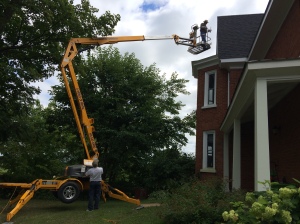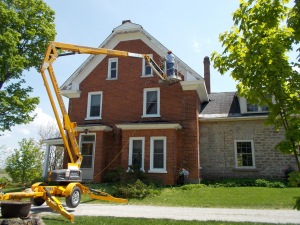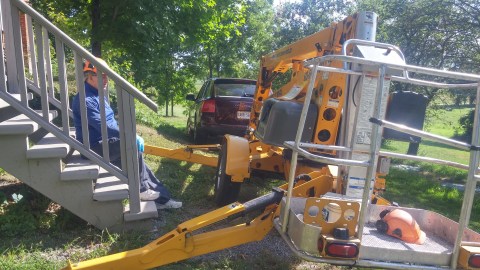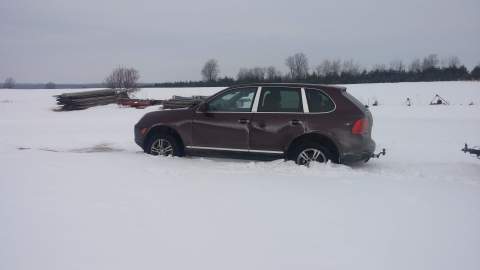Weekend with a 45′ Bil-Jax man hoist
August 25, 2019

After painting the steel roof beneath the bucket, I had to repaint some areas splintered by the roofers’ nails, and get rid of two old wasp nests at the very highest point of the cornice.

A mysterious, splintered hole appeared in the coping above where I am applying a tidy patch secured by many small brass screws to bend the plywood to the contour of the moulding.
I had a host of little jobs to do around the 1896 brick house which would have been at the upper end of my 40′ ladder. But it is too heavy for me to put up by myself any more, and I can rent a really cool tool, an electrically-powered cage with which I can climb in comfort while taking along my power tools, paint, and mortar, all in the same trip. Cash in some ways can be a substitute for youthful vigour. Bet appreciated having our friend Les around to operate the hoist and easing the pressure on the spousal unit.

This is a shot from the May, 2016 session where over three days we scraped and painted whatever was white, wherever we could reach it from the bucket.
The only catch is the rig’s weight. At 4200 pounds it’s a bit too much for my 4 cylinder Tacoma with its elderly and much-maligned frame. Even the rated 3500 pounds towing capacity seems heavy for the venerable old truck.
Of course Ruby, my 04 Cayenne S, is rated for 7400 pounds, even if it has been sitting in disgrace since I concluded that her replacement, a 2014 Lexus es300h hybrid, costs 2.7 times less per mile to drive. But I needed a relatively heavy duty vehicle to pick up the hoist an hour away in Kingston, and prices are down again on premium gas, so Ruby got the nod and a chance to redeem herself.
Ruby’s build sheet lists a factory trailer hitch for $2000 and change, yet it has given me fits to get trailer lights to work on the thing. I finally used an adaptor for digital bulbs into which I drilled an additional 12V lead, the other end plugged in like a cigarette lighter to the rear-hatch 12V feed. I connected the constant 12v feed to the running lights for the trailer. Then the signal lights would work. Brake lights? Gee, Officer, they don’t work? Are you sure? I just have to remember to shut off the lights.
My son’s Cayenne has an after-market hitch and his lights work brilliantly. My inability to solve this signal light mystery was not for a lack of trying, though it has removed Ruby from contention as a tug for my son’s 20X8.5 enclosed car trailer.
Anyhow, at the rental place Ruby of course refused to fire the Bil-Jax’s signal lights. A bit of contact spray the rental agent had got them going. Once under way, Ruby handled the long, unwieldy device quite well on the road, and we soon arrived at the farm.
It was when I had to take the Bil-Jax up and down a steep slope and along a terraced driveway that I gave Ruby’s low range and centre differential lock a chance to work. Both functioned flawlessly on an off-camber path which unweighted one wheel after another. The diff lock and low range shifted out as easily as they had engaged. An ’04 Cayenne is a serious tow vehicle at 1 km/hr. I wonder how many Cayenne owners have really tested the low-speed pulling abilities of their pigs?

Les operated the Bil-Jax for all sessions, leaving me to juggle masonry, woodworking, and painting equipment in the bucket.
The Bil-Jax has a series of three hydraulic cylinders controlling booms. The topmost boom had a fault whereby it started off with a vicious outward whack, regardless of whether it was asked to raise or lower the cage. The instrument panel in the cage was ideally situated to injure a vertebrae on an unwarned passenger who was standing with his back to it, holding a pitcher of paint, for example. Paint falls down through the expanded mesh of the cage without a problem, though it wreaks the usual havoc on brick and stone 40′ below.
Apart from the spilled-paint debacle, the rig allowed us to get a lot of brick repair, painting, tin roof painting, bee’s nest removal and the repair of a hole chewed by a squirrel into a chestnut fascia board 40′ above the ground. Go figure.

Here I am at the height of an extended 40′ ladder, repairing the hole a squirrel carved in the fascia board of the house. A family of greys climbed the brick wall all winter to use their penthouse den.
The 110v feed in the Bil-Jax cage proved quite handy to run a reciprocating saw while I fitted a plug for this hole. There’s also an air hose installed on each machine, though on the last one it was easier just to run a 100′ hose straight from the compressor to my nail gun.
At just under $300 CDN per day for rental or for a two-day weekend, I find the World of Rentals product a good value.
It turns out that Ruby still has considerable fun potential at the farm, even if Cayenne ownership seems rather fraught in comparison to the mindless ease of a Lexus hybrid’s.
Ruby doesn’t do off-road.
March 13, 2019

It was a simple task. Put the utility trailer back on the slightly elevated area where it sits in my trailer yard. There was a bit of a snow drift, but so what?
Before I knew it, Ruby was stuck. I disconnected the trailer and realized that there was a fair amount of snow in that drift, and the ground underneath was pretty icy.
Low range and diff lock did no good. I had forgotten all about traction control and how to turn it off. Maybe that is the button on the dash with a three-letter acronym.
Desirable characteristics of an off-road vehicle are flexibility, light weight, simple power train and aggressive tires. Ruby is the antithesis of this, regardless of winter tires, 4WD, differential lock and low range. She still behaves like a lead anvil once belly-hung on hard snow.
Towing requires a second driver because you can’t leave the car in neutral if you want to remove the key, and if you leave the key in the ignition, Ruby may lock you out if you jolt her through the tow rope.
I matched my 35 hp tractor to the Cayenne. With snowblower, cab and loader as well as loaded tires with chains, the TAFE weighs about the same as the Porsche. At 5400 pounds, Ruby is too much dead weight for my little tractors. My wife operated Ruby correctly and the behemoth came out of the snowdrift after several sharp tugs from the tractor through a 30′ tow strap. No, I did not hitch the strap to the tow ball. I looped it over and around the ball holder.
Ruby does fine on the highway, but I don’t want to go off-road with a vehicle I can’t push.
Why does the Porsche Cayenne lose so much value so fast?
January 29, 2019
Why buy a car? (another Quora question)
January 17, 2019
A car provides a space where you are effectively autonomous. This power is the result of mobility and anonymity. For the teenager its initial appeal is sudden control over vast distances. The process of conquering the previously inaccessible develops the taste for freedom in the forms of speed and unsupervised time with others, the chance to cut loose.
For my generation the car was the trysting place of young love. Woe betide the swain whose mechanical skills weren’t up to the task of reviving the battery of his car in the gravel pit at the end of a country road with the local clergyman’s daughter in the front seat beside him.
A car is its own economy. It provides mobility, the product, in return for considerable effort to pay its costs. This usually involves using that mobility to go to a variety of places of employment at regular hours, so the car imposes a discipline on the individual which we generally accept as normal in Western society.
Leaving the farm for life at university comes as a wrenching change to the young auto enthusiast. All of the sudden in a high-density environment, a car is a real nuisance and his newly acquired repair skills are in low demand. Parking on campus is prohibitively expensive. Cars are the fashion statements of well-to-do fathers and there is no correlation whatever between the price of the car in front of the residence and the level of satisfaction of the kid in the room above.
Walking provides amazing mobility in the microcosm of a university campus, but a bicycle is even better, if less anonymous. Kamikaze rushes across campus to the lunch room fill the need for speed, and the frequent short stair descents on the route provide adventure. Winter riding enhances these thrills, especially when a blast through a snowbank encounters a fire hydrant.
A car is a much warmer vehicle in winter than a bicycle. It is also much less likely to lose traction on an angled railway crossing under slush, or to spin out on glare ice and slide into a curb.
One’s first new car is a shining, wonderful thing, a sensual delight of smells, sounds, and G-forces. It comes with worry. The owner signs away his freedom in a contract promising to pay a significant amount, each month, for the foreseeable future. The new job imposes even more regularity to the driver’s life, this one with a 35 year contract.
Over the duration of this contract marriage and dogs, houses and kids happen, the trappings of a happy, successful life.
All to pay for that first new car.
Ruby and the utility trailer in a tricky location
January 2, 2019
The fill around our expensive septic tank seemed to be receding, and it had left what looked like a truck tire track along the uphill edge of it. This did not look good for winter frost, so today I resolved to repair the damage. I called Don Day, the installer, to ask him where I could find some topsoil which wasn’t frozen. He offered a load today at about 1:00 from a basement he was digging in Seeley’s Bay. I hitched Ruby to my newly acquired 1996 4X8 trailer and turned up on time for a half-yard bucket of beautiful, dry, clear, black topsoil. A house is going on the site.
Our septic tank sits on a side hill, down below the basement of the stone house and above an old orchard. The problem is getting a heavy vehicle up the hill or down from above without crushing the drain from the house to the tank.
On the twenty-minute drive home I thought about possible approaches to the septic tank, and eventually decided to try to deliver the trailer with Ruby because it would save scarce time, avoid re-hitching, and the last time I messed with this particular slope and a trailer, I’d rolled my lightweight Bolens tractor down it.
A narrow relic of a driveway makes its way around the house in classic Georgian style. Below it is quite a steep slope which has challenged all vehicles, including the lamented Bolens. The trick was to drive up the slope onto the narrow driveway, avoid an encroaching dogwood, gain the lip of the road with the trailer, and then, before the driveway ended in another landscaped slope, stop and prepare to back the trailer fifty feet to the septic tank in need of the fill. The final approach ran around a corner with the dogwood on one side and a walnut on the other, warning me not to venture too far over the edge onto the slope.
Ruby’s low range and differential lock work beautifully when one really needs them. By my standards this was a difficult trailer-positioning job, and the Cayenne did its part with ease, even when one wheel and then another were forced to venture over the brink onto the slope below. The differential lock simply engaged and the car continued backing the recalcitrant trailer up to the mark.
I shovelled vigorously and the dry topsoil had little frost in it, so the job was completed in the extremely restricted time frame allowed (snowstorm tonight).
Ruby did well. I should have taken photos, but I was too busy. Sorry.
“How good is a 2003 Cayenne?” Quora response
December 30, 2018
Error codes and the O2 sensor
December 7, 2018
Ruby has been running like a dream since the OEM ignition coils went in. Then this week she popped a Check Engine Light. P0050. Bank 2, Upstream Oxygen Sensor, Heater.
I read all I could find about the four faults which eventually showed up: P0050, P0155, P2254, P2247. The thing all descriptions have in common is that a likely cause is a failed O2 sensor in that location.
I checked the wires as well as I could without removing the sensor. Everything seems fine, though the previous tech wound the wires up a few turns when he or she twisted the sensor in. The sensor was also quite loose when I investigated with a 22 mm wrench.
Because I had the car on the hoist with the bottom plate off, I went ahead and did an oil change. I also erased the codes in the faint hope that tightening the sensor would do the trick, but by the time I had completed the run-in of the new oil, P0050 had popped again.
I called around for an O2 sensor. Porsche matched NAPA’s price for a BOSCH unit at $230 CDN* plus tax or $260, and offered the OEM model at a one-time price of $250 CDN plus HST. The catch was that the BOSCH would be available next morning. The Porsche item might take some time.
My son picked up the BOSCH sensor in Ottawa this morning.
More to come, no doubt.
*Before readers react in horror to this price, the U.S. dollar is trading at $1.34 CDN. Pelican parts wants $134.50 USD for this part. That would work out to $210 CDN with exchange and HST, so it’s hardly worth the delay, 1 1/2 hours of driving, bridge toll of $3.00, and a Kinek fee of $6.00 for the online product. The Porsche price is also a few dollars cheaper than the NAPA price listed on the NAPA Canada website. On the other hand, a Cayenne S has four of these sensors, all different, but all expensive.
This expense marks the first time I have given any serious thought to the high cost of maintaining this car.
UPDATE: 9 December, 2018
Charlie delivered the new O2 sensor from Ottawa and helped me remove the old one and thread in the new one. An extra set of young, experienced hands was a big help. Before the new sensor came, after I had changed Ruby’s oil I erased the codes and drove it briefly, then raised it, running, on the hoist to check for leaks. By the time I had the car back on the floor it had popped P0050.
This time, so far at least, there are no codes.
While changing this sensor is no picnic, we both agreed that it was considerably easier than replacing the alternator on the family Lexus.
UPDATE: 10 December, 2018
The first hour of driving produced no codes. Fuel mileage is marginally improved, back to the level it was before the sensor began to misbehave.
UPDATE: 14 December, 2018*
The OBDII meter moved back to my truck today. Ruby seems fine, now.
*I actually made the switch yesterday, but such is the state of my triskaidekaphobia that I falsified the date <weak grin>.
UPDATE: 2 February, 2018
Ruby has been very well-behaved since the O2 sensor replacement. With the OEM coils the engine is marvellously elastic, though fuel mileage has taken a beating with the switch to winter gas at the local stations. On the other hand, gas prices have dropped sharply, and as long as premium is priced at under $1.25 per litre, Ruby’s replacement with a Prius AWD recedes into the future.
Winter driving hazards
November 25, 2018
The most hazardous stretch of highway I have encountered this year is the 3.4 mile section of County Road #42 between Philipsville and Forfar. Twice my vehicle has left the road for the shoulder due to icing.
The first time occurred just as I passed the Elgin turnoff and climbed the knoll to approach Philipsville. All of the sudden the road was slippery enough that my SUV drifted over onto the shoulder, then recovered the lane at a bit over 100 km per hour. Strange, no other portion of the 33 mile drive that afternoon was slippery.
Yesterday evening on the return trip from Easton’s Corners I watched Ruby’s thermometer gradually descend from 4 degrees C to 1 C as I drove up the slope in Philipsville in a heavy fog and light rain. Needless to say I drove a lot more carefully this time. Nonetheless, about a mile later, at about 70 km per hour, on a straight stretch, Ruby slid off the road into a set of newly-formed tracks on the shoulder before recovering. There had to be a patch of black ice there which had nabbed someone just before I came along to account for the identical tracks on the shoulder.
It surprises me that this stretch of road should hide hazards. The pavement is by a considerable margin the best of my route. Unlike the stretches to Toledo and Jasper, the road is straight, has wide shoulders, and until recently was a provincial highway. The variable might be that there is little traffic on this road. Perhaps the salt truck drivers see greater needs elsewhere.
I could attribute the first slip to speed or carelessness, but in the second case I drove expecting black ice, and Ruby slid off the superelevation of the lane, just the same.
Until maintenance improves on this section of #42, don’t trust the traction.
Ruby’s ignition coils
November 10, 2018
Last night in a snowstorm I drove Ruby behind a pair of snowplows for about fifteen miles at speeds ranging from 33 to 47 km/hr. The engine didn’t miss a beat.
Two weeks ago I had bitten the bullet and bought $611.00 CDN worth of Porsche coils from Mark’s Motors in Ottawa and installed them. Had I tried to make do with the deteriorating coils I had bought two years ago from Amazon.ca, I might not have made it home under the damp, claustrophobic conditions.
Asian knock-off coils seemed to work adequately at constant, relatively high speeds, but if I slowed down for traffic, one or another of them would misfire until I had the car back up to speed. The big problem in diagnosis was that it takes a 2% deterioration of spark for the car’s computer to set off the check engine light, thereby allowing me to track the error code to the correct cylinder for a repair. A coil would spend about a month teasing me before becoming bad enough to allow me to identify it.
This greatly reduced the enjoyment of driving Ruby.
Then P0307 flashed on the code reader. #7 had failed outright in Athens, and I barely made it the twenty miles home because the oxygen sensor shuts down the fuel supply to a whole bank of cylinders on the V8 to protect itself when a cylinder misfires. When I removed the coil, it smelled like the inside of a burned-out computer. #7 is easy to switch, so I dropped in another Asian coil. I had a box of them on the bench from a warranty settlement from the Amazon vendor. Experience showed that half of them work, for a period not to exceed two years.
With the new coil Ruby started right up and ran normally. After she was well warmed up, the slight miss recurred. It wasn’t the bad coil which had failed. It was another one.
That was the last straw. When I complained about the Asian coils on the Porsche blog, the only comment I received was from the moderator, who wrote words to the effect that Cayenne owners have learned a long time ago not to use that product. In some batches none of the cheap coils would actually work.
Ruby has not been an expensive vehicle to maintain over the last 2 1/2 years, and with the new OEM coils she’s twice the car to drive.
Emergency tool list for Cayenne S
October 18, 2018
Today an ignition coil on my Cayenne failed in Athens. The car immediately began to shake and miss. Fuel consumption went from 11.8 L/100 km to 14.4 L/100 km and the check engine light came on almost immediately. The CEL reader showed code P0307. That meant that cylinder #7 was missing. I gritted my teeth and drove the shaking car the twenty miles home, but a longer trip would have necessitated a tow truck.
Normally a failing ignition coil on Ruby is like a slight toothache, a niggling annoyance interrupting an otherwise serene driving experience. This one was an outright failure more like a broken ankle. When I eventually removed the offending coil, it smelled like a burned computer component.
Because a coil can fail at any time, regardless of its quality level or age, I have decided to pack a spare against eventualities, but realized it would do no good if I didn’t have the correct tools to make the switch, so here is the list for ignition coil replacement:
long #30 Torqz screwdriver does most of the work.
#15 Torqz screwdriver releases the screw which holds the right beauty panel to the windshield washer fluid funnel
1/4 ratchet with 9″ extension, 8 and 10mm sockets
#30 screwdriver bit in mini-ratchet gets into a couple of tight corners where the screwdriver can’t loosen machine screws
3/8 ratchet with 9″ extension and sockets of 8, 10, 16, 5/8″ spark plug and 12 mm triple square
second ratchet or 16 mm box end wrench
large plain screwdriver for beauty panels
large upholstery prying tool to remove the coil from its den
error code reading tool
Bank 2 coils are easy. Bank 1 has less space, and you have to remove an engine mount. It’s not a bad job at all, but you need to get that triple square nut off unless you have already replaced it with a 16mm nut. The 5/8″ socket is to check the tightness of the plug when you remove the coil. I found one shaken loose once.